Dena Hankins's Blog, page 13
November 2, 2022
NY-VA Day 1: And off we go!
We went to Port Washington on glass water in a thick forbidding fog that engulfed our little world all the way to Manhasset Bay. That’s where the gloom released it’s grip to let us anchor and sleep. It was a terrifying necessitous experience. Only one beautiful moment remains in my (Dena’s) memory. The fog was so thick that visibility at water level was less than a quarter of a mile, but it thinned overhead enough for a beam of sunlight to penetrate and gleam on the water. The softly waving water surface became riddled with catspaws for a moment and I saw silvery lace curtains, blown in a gentle breeze.
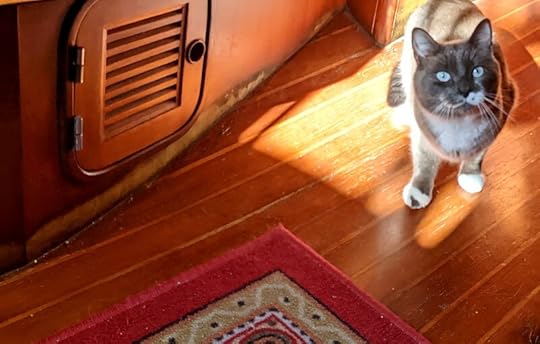
Port Washington is familiar to us. Groceries, laundromat, and good eats within an easy walk of the town dinghy dock, it’s been kind of a favorite for the past few years. But the town’s harbor plan has been hijacked by the corporate non-entity marina machine, and that has had a rather dramatic effect on the overall feel of the place.
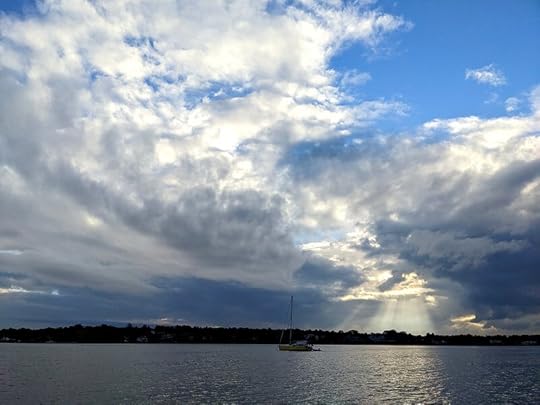
They (the town of Port Washington) used to have a bunch of moorings sponsored entirely by the city, free for 72 hours. As a cruising sailor, you could roll up on one of those moorings on a Friday and live the good life for an entire long weekend for free! Now I (James) don’t really know if it was a direct cause and effect relationship, but shortly after the nightmare-multinational-marina-conglomerate takes over two of the local marinas…all the sudden the town doesn’t think they should be leaving that good rich-boater money on the table anymore. This year they started charging after the first “solar” day. Well, fuck a bunch of that – we anchor our boat.
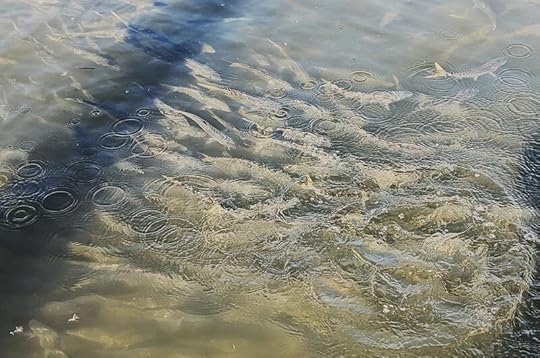
Of course, that means that when we decided to take the late-night fair current through the city, we were hauling chain in the dark. It was a good decision…we had enough wind to sail most of the trip but not so much as if we had left during the big blow-up on Thursday. A couple anchored nearby, on a boat we’ve seen on and off all summer, chose the 12-hours-later fair current and lost the wind very early along the Jersey Shore.
Thick sticky mud is what I (Dena) remembered from previous stays in Manhasset Bay, but I couldn’t see a thing and just cranked that windlass handle until the anchor was at the waterline. Still air made it easy, but I just knew that there was a muddy mess being deposited in our chain locker…which is located at the foot of our sleeping space. Oh well!
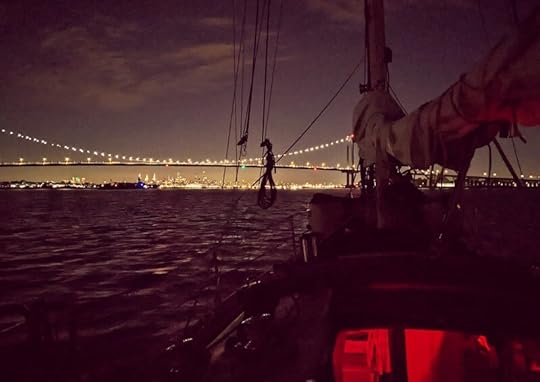
James drove from midnight to 1am and then I took over. The East River at night is rather disconcerting, to say the least. So many lights, all of them moving according to the perception of the viewer who is underway. Paralax provides information about which are closer and which are farther and then all of a sudden there’s a light that isn’t moving across the background at the rate of the rest of things and it turns out that it’s a tug with a 300′ barge using the same waterway and in much more need of space and capable of much fewer dramatic dodges.
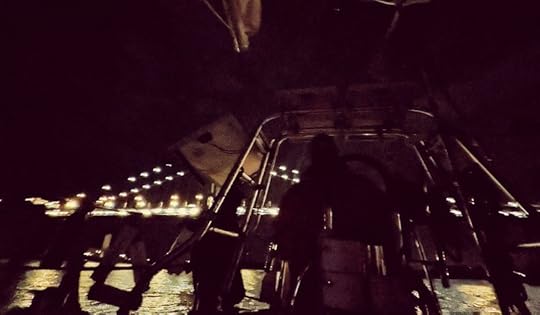
Alert? Yeah, I was alert.
Another sailboat was taking the same fair current. They had an AIS transceiver, meaning that they send their information and also receive. That signal told us that the boat was named Osprey, that it was 36′ long, and that they were traveling at roughly the same speed we were. Our AIS is receive-only, meaning that we are visible to other boats only by eye and radar, not with that identifying signal that the other boat had.
Just after Rikers I (James) took my second short-dog-watch. Dena had the helm through the unlit channel between North Brother and South Brother and I took it as we came into Hell Gate. The other stick-boat had opted to go outside of North Brother, a longer route, so I backed her way down to let let them catch up and pass us going into Hell Gate.
Wow, New York City on a Friday night/Saturday morning between 2 and 3 am! If you’ve ever experienced the proverbial “City That Never Sleeps” with Harlem to starboard and Brooklyn to port, you really haven’t experienced that city! But I (James) have now thoroughly experienced that town, let me tell you!
Coming into Hell Gate at 9.6 knots following the stern light of the boat ahead of me…to make sure I don’t hit them… I am inundated with the awesome light of the biggest fucking city in the U.S. of fuck’n-A!
Manhattan screams but Brooklyn growls so I got in the Bike Lane on the East Manhattan side and rode the East River’s torrent for an incredibly interesting hour from Harlem to the Battery, switching my view from the NEW YORK AWESOMENESS to the chartplotter by the second. I somehow, no really somehow, managed to not kill my family that night.
(Dena and Beluga say good job and thanks.)
There were five Disco-Boats. The first one I didn’t see until that fucking piece of shit was right on top of me. It looked like a painted up WWII crew transport with a vera-light rig and a mirror-ball. The second, third, and fourth were almost identical to the first but somehow louder. The fifth one, I could swear I heard an interlocutor call out B-23 and a faint… Bingo!
Photos, AYFKM?! Remember the saving my family part? Well, it was their turn.
…shift kiss!
I (Dena) took over. I hadn’t been drawn to the nighttime city the way I thought I might. It could be because of what makes NYC special to me to begin with…the Art Deco architecture. I’m not really about the bright lights, so it was less compelling at night.
I aimed us between Governor’s Island and Brooklyn. The other sailboat appeared to be taking the ship channel route, which I find ludicrous because, well, it’s where all the big ships are! I prefer to head through the Upper Bay ship anchorage, where the brightly lighted ships are all anchored instead of making way and unpredictable.
That got me to the Verrazano Narrows bridge just ahead of the slightly-fast sailboat that had gone around the anchorage and they, once again, kept to the ship channel where I went through the Gravesend ship anchorage. The sheer number of ships, anchored and underway, was unprecedented in my experience and I was so very glad to have the AIS information to confirm which were which.
…shift kiss!
With the single reefed mainsail aloft. Oh yeah baby, here we go! Between the 1,000 foot container ship and the 685 foot fuel tanker was a gap of about two-thirds of a mile…um, “in these shoes” no fucking way! After the thousand-footer there was a 25 minute gap between that and a procession of massive Carnival Cruise ships. I (James) crossed the bow of a ship with a fucking roller coaster and a crane-ride with a little over a mile to spare between the red and green ship-channel markers. We were now in the Atlantic Ocean! Hello Jersey Shore.
So many shift kisses! We usually do three-hour watches overnight, but we correctly guessed that we’d need to trade off more often than that through the city. We’d gone to bed at about 7pm and, amazingly, got some good sleep between then and the 11pm alarm. It was getting to be a long night, though, by the time the sun came up behind the clouds.
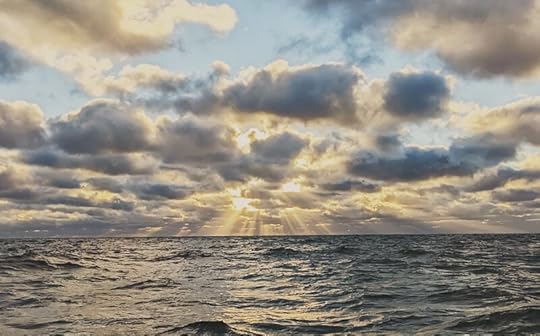
As we’d come out of New York Harbor, the wind had picked up enough for us to sail. As we corrected our course for staying near the Jersey Shore, it became a good angle for adding the yankee. We proceeded to sail, watch on watch, down and down and down.
I (James) was in the Atlantic Ocean, sailing. The cat was relaxing in the cockpit to leeward and I was a-windward. The boat was performing to perfection. LoveBot was barely working and the sun shone in all its oblivious glory. The world was absolutely alive all around me. I fiddled with the course a bit, then a little more until the rig started to rattle and complain so I opted to gybe. I set the down-wind angle on LoveBot 45 degrees to lee and she slowly went aft through the eye of the wind. I decided to coax the mainsail around by giving the sheet a tug to starboard when a gust pulled it back to port. I was in that monkey-hold position and it yanked me hard up against the port side companionway slider. Pop! went the rib right under my heart.
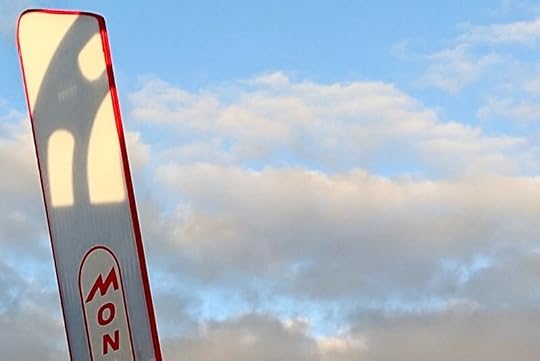
Motherfucker!
I have popped the cartilage in my rib-cage so many times that I know it the second it happens. First a sickening pop occurs that I can hear throughout my entire body. Then a weakness takes over and I go limp. Then I rasp in a breath and the pain descends. At first it doesn’t hurt all that bad so I assume the injury isn’t as bad as the last time it happened. But it is, and I discover that the next time I exert any physical stresses on the injured rib. Six weeks later, I’m no longer in any pain. That is if I don’t injure myself again in the meantime. I hate this kind of pain. But here we go again.
Dena came awake pretty quickly, handed me a handful of ibuprofen and ordered me to lie on my back and get as comfortable as I could as fast as I could. She was right – the swelling wasn’t too bad after a half hour of down-time I felt much better.
I (Dena) knew that James was Not Okay, but not exactly how far from okay he was. Once he took his next watch, I used every tool at my disposal to create a series of ditch points, places where we could opt to stop corkscrewing in the waves off the port quarter and let his damaged body rest…at rest. Barnegat Bay was the first option, one which a Mystic Whaler dude had told us a lot about. Atlantic City…nah, we would not be going there.
The last of the stopping options was Cape May, whether by actually stopping in the town and anchoring off the Coast Guard station again or by getting out of the oceanic swell and heading up the Delaware Bay. A stop in Cape May meant a few days of waiting for the next opening while going up the Delaware meant a few weeks’ delay. The upside was short, easy days while James’s body dealt with its damage.
With LoveBot driving, we were able to trim with the yankee as needed, bringing it in and out as the wind veered and backed just enough to blanket it behind the main, so my watches for the rest of the day were almost effortless. Cetacea was in her element and taking good care of us. We didn’t need to go into Barnegat Bay.
The sky started looking really good in advance of the sunset. We were off Mantoloking, NJ, when I (Dena), enjoyed the show just before James took his first long watch from 1800-2100.
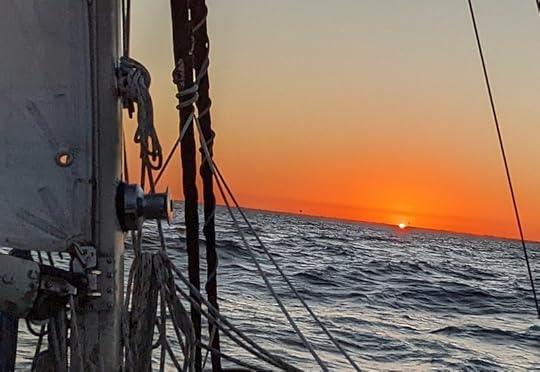
I (James) faced the night with a hand full of pills and a half pot of coffee with a kind grim determination that survival stories are all about. I was going to survive this with the mast up, the keel down, the crew in the boat and the water out. And that was it that was all I could imagine I was going to do.
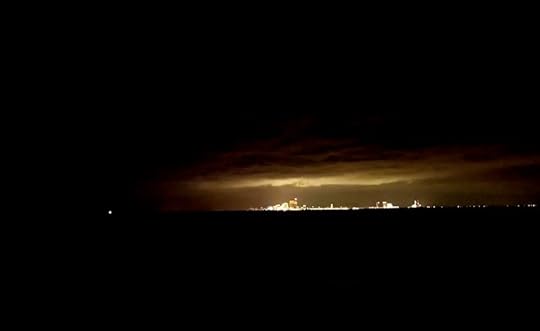
Atlantic City consumes a lot of oxygen for a boater doing the shore route. We were subjected to it for hours and it did a fine job of ruining the bits of sky that weren’t already clouded over.
On the other hand, the wind waves and swell weren’t at quite such cross purposes, and we were making good time. We were past by midnight and the end of our first day.
Day 1: 121.8 NM, average speed 5.13 knots, max 9.76 knots

October 24, 2022
We fix our shit
Stonington, Connecticut, has a really shitty anchorage! Like in most of New England, all the good anchor spots are littered with moorings, most being empty this time of year. But Stonington is a special kind of shitty. The town is protected from a substantial Atlantic Ocean roller by three breakwaters. One is south of the town waterfront about a half a kilometer offshore.
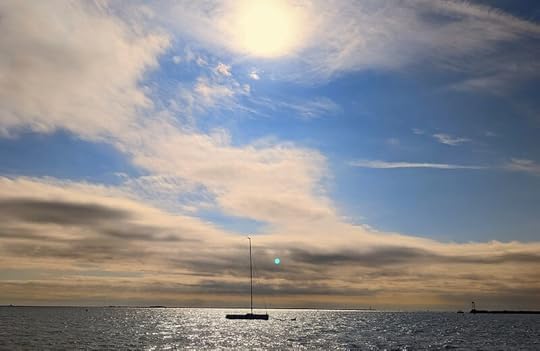 Looking South to the Offshore Breakwater
Looking South to the Offshore BreakwaterA second breakwater about the same size as the big one offshore is located west of town protecting the village from those big sou’easterlies that roar up Long Island Sound in the summer. The third one is much closer to town and protects the inner harbor and all the marine industry. The one place left for a traveling sailboat to anchor isn’t protected by any of the breakwaters. It’s wide open to both the aforementioned weather elements that used to make it a crappy place to live.
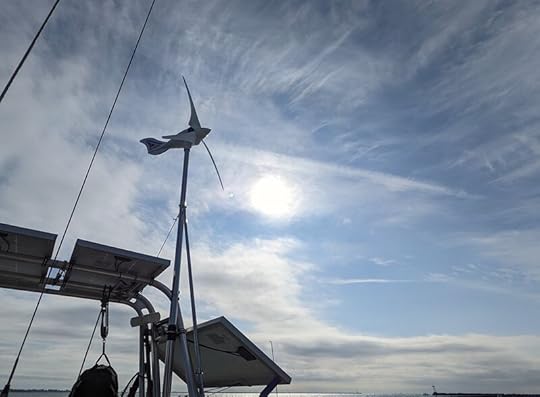 Yeah, we made plenty of power!
Yeah, we made plenty of power!With a dead engine and a fucked up self-steering system our choices were pretty limited. Fortunately for us, our friend Jimmy (the same guy who sailed up to Point Judith in the last post) was happy to help us out.
We had two days of intense weather at anchor from all the directions left unprotected by Stonington’s fancy-schmance breakwaters, so we ordered a new (and a spare) fuel pick-up pump off the internet and had it sent to Jimmy’s place in Noank just a few clicks up the highway.
The Monitor project came first, since it shouldn’t (please) require any parts. I (Dena) was worried we’d lose the circlip that had to be removed so that we could take the lower teflon bearing out. Once that bearing was out, we’d have full freedom to realign the gears.
In preparation for the project, we pulled out the bag of Monitor spare parts. Not only did we have a half-dozen of those circlips, we even had a replacement for the worn-down bearing!
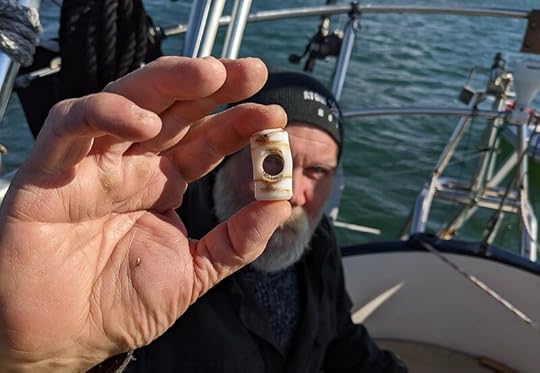
In the ridiculously rough water of “protected” Stonington harbor, not only did I pop that circlip off and lose it right into the water, the shitty multi-end circlip plier set came apart while I was trying to use it and bits of it sank as well. Moving on with gritted teeth, I made do with a tiny set of needlenose pliers.
Once the Monitor could move freely, we realized that there were two alignment issues. Fixing the gearing still didn’t make the rudder face the right direction! The whole rudder assembly meets the hinge by sliding up into it. A nut-and-bolt squeezes a gap to clamp it into place and that thing was completely loose.
I put the bearing back in (with two washers that had been missing when I took it apart) and then did an irritating amount of thumbnail wrestling of the new circlip. I only lost one more to the sproing and the heaving of the dinghy under me.
James handed me a monkey wrench and eyed the angle while I turned it a bit at a time and then, voila! Everything was lined up correctly. I tightened the bolt to hold the rudder in place and got out of the dinghy as fast as I could.
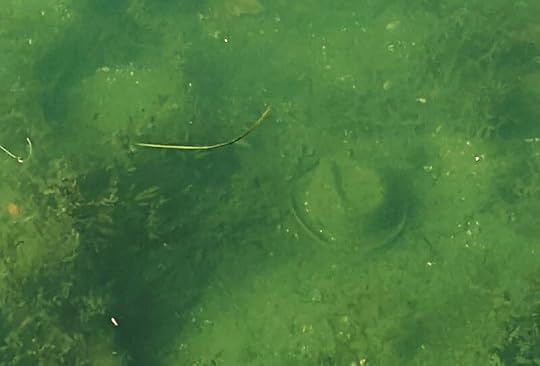
On the day our package arrived, Jimmy was nice enough to take us out to lunch and let us shower at his place, which is always a welcome thing for us. We had another enjoyable visit and then he dropped us back so we could get that new pump installed. For an engine project, it went pretty well, right down to bleeding the air out of the system at both the filter and the fuel injection pump.
The next morning, we took off with the current and motorsailed on glassy water to a hint of protection behind Tuxis Island off Madison, Connecticut.
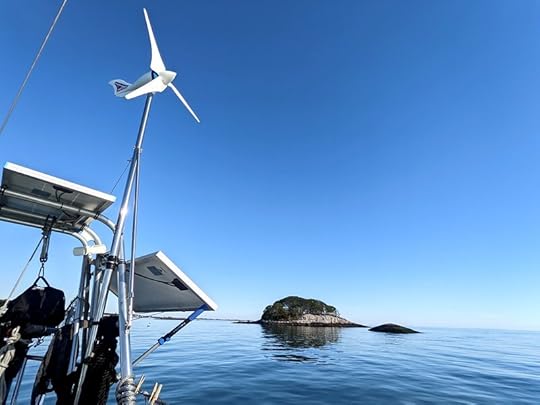 The Island of Tuxis, CT.
The Island of Tuxis, CT.We’ve been focusing on hitting new spots, and the weather cooperated by giving us northerlies and easterlies. Most of the places we’ve been are all about protection from the summer’s prevailing sou-westerlies, so the weather has nourished our sense of adventure.
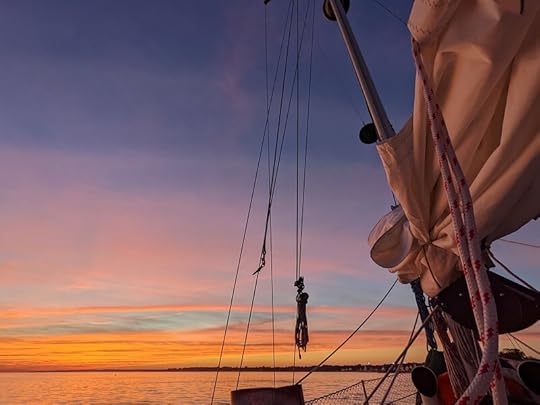
The next morning, we woke bright and early again for the flood. The engine dry coughed and we cussed our way through bleeding yet more air from the fuel injection pump. Finicky things, these diesels, and we’re fucking over it. Once again, we got underway later than we’d planned and missed some of the fair current we’d been counting on.
I think we’re at least 6 weeks behind where we’d be without all these engine problems and what if we had made it to Europe? Dealing with all this while in foreign countries sounds like the very worst way to spend our limited cruising time in Schengen countries. The vibration is hard on every damn thing, the noise and smell are noxious, and the cat hides whenever we start it up. There’s nothing, at all, to love here.
Luckily for us, the wind came up that morning and we were able to shut that fucker down and SAIL!
 Our working Lovebot
Our working LovebotOutside Milford Harbor in what they call “The Gulf”, we anchored several hours before the rains hit and we quietly sailed this boat all the way into the anchorage. We’re sitting here still, letting the bad weather pass us by, peacefully at anchor.

October 19, 2022
Sailing on…and on…
I (James) was really stoked about this next part of the adventure.
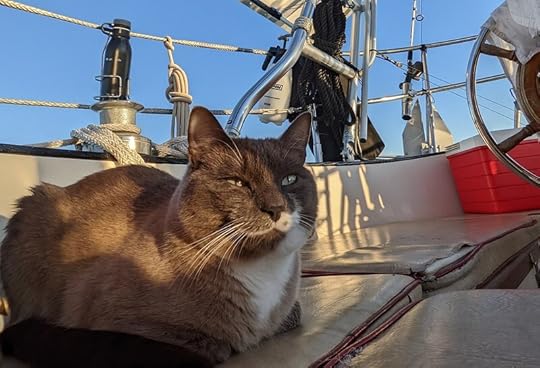 Beluga Greyfinger smiles
Beluga Greyfinger smilesNot only could I not wait to use the watermaker again, we were sailing to a place we’d never been before. I mean, yeah, we’ve anchored a lot in Buzzards Bay all over. We’ve even anchored off Naushon Island (on schooner Mystic Whaler on the Eastern side of the island) but this was me feeling things anew. For one thing, I wasn’t sick anymore and that felt great. But the best part was we were moving under sail once again relative to the rest of the multiverse and I was simply amazed to witness it all.
The wind, the waves, the current were all with us and we bowled on to our evening’s anchorage with all the power we could muster. It took less than three and a half hours before we were anchored in the cool clear waters of Kettle Cove between the islands of Uncatena and Naushon in the Elizabeth chain.

James wasn’t the only person happy to get to this new spot. Beluga ran around the deck like he does at night when he feels safest. James and I (Dena, in case there’s any confusion) are thrilled to enter a strange cove and find it empty, and Beluga might pick up on some of that. It was a lovely evening after a short, easy day.
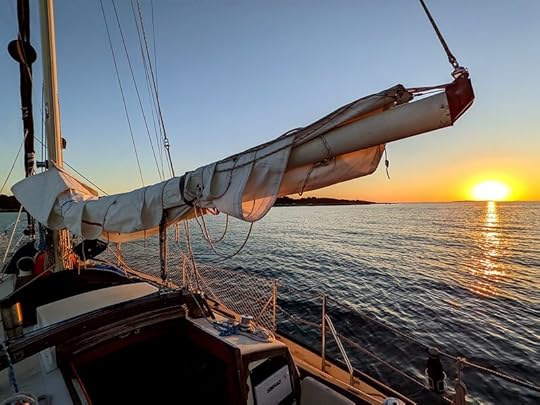 Hook down Kettle Cove
Hook down Kettle CoveShyte and Briney in the morning, we were underway on glass by 0700 pointing the boat at 268 degrees magnetic to Point Judith Harbor of Refuge. A place we know so well.
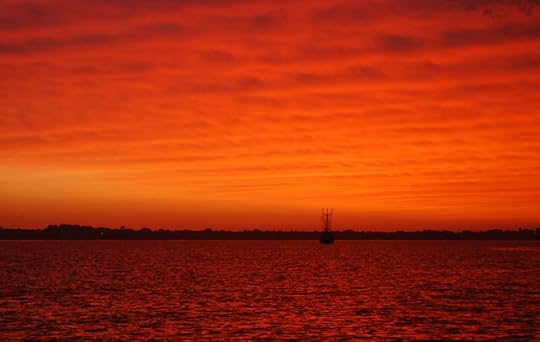 Point Judith Harbor of Refuge in 2012, the first time we anchored here
Point Judith Harbor of Refuge in 2012, the first time we anchored hereOur friend Jimmy has more salt in his blood than any other man we know so when he tells us he’s sailing to Point Judith Harbor of Refuge to raft up and have some drinks that’s pretty much what’s going to happen. He was sailing out from Noank on his Crealock Pacific Seacraft 31, S/V Imari. When we left Kettle Cove Jimmy asked me when we thought we’d be in Point Judith and I told him my standard answer…Like the Cable-Man between 2:00 and 6:00. If you rely on us to be some place you kind of have to fuck your whole day to make it happen. So just about sunset Jimmy pulled up single-handed to our port side (to which we list a little), presenting his starboard side (to which he lists a little) and a plethora of fenders in all shapes and sizes. His slow approach was perfectly done, never stressing us out.
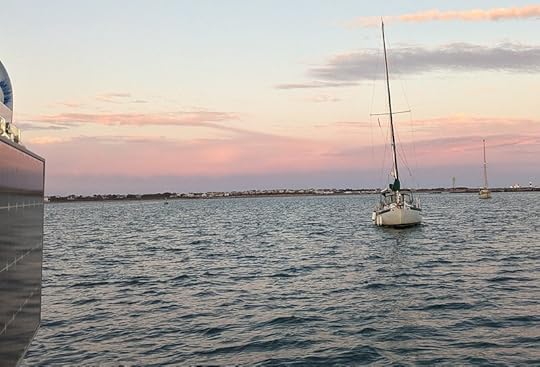
That’s saying something when someone’s driving their boat directly at ours!
Because our lists were bringing us closer together and Imari has outboard chainplates, the view of the rigs was…disturbing. We moved him a little aft and all was well in the multiverse once again.
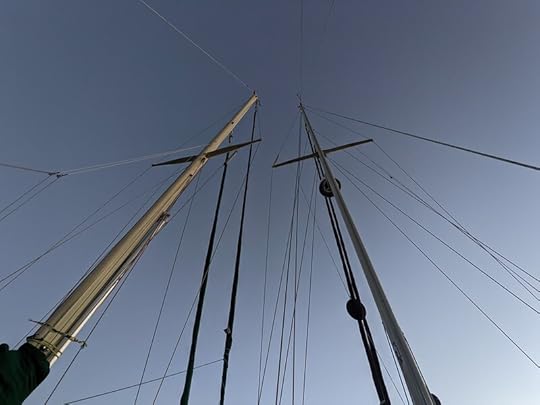
The sunset was gorgeous and we very much enjoyed the conversation. It’s so rare for us to have anyone aboard, let alone have someone meet us on their boat, and rafting is very close to unheard of for us.
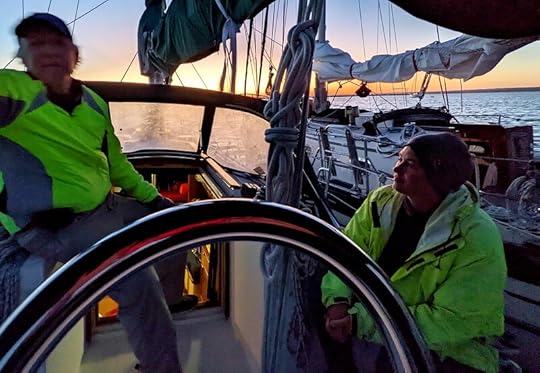
All those factors made it that much more fun to do. We all got up early the next day and Jimmy was motoring off by 7am.
We tried to leave right after, but our flaky diesel boost pump died altogether and we had a terrible time getting the engine started. When it did start, the belts screamed bloody murder so we shut it back down. There was no looseness, so we figure the alternator just had a lot to do after cranking the starter so many times (and yes, letting it cool down between times). With the fuel primed and the house bank helping the starting bank, we got it running again on the first try.
Damn engine is the number one headache on Cetacea, and a heartache as well for a couple of people who don’t want to pump fuel ever again. Going electric is a big investment in both time and money, but we’re closer and closer to biting the bullet and making it happen every time this kind of delay causes us to miss weather windows.
That’s what happened. Once we got out of Point Judith, we were running behind our plan which meant that the southerlies came up while we were still exposed in Block Island Sound. We started out full sail and pulled the first reef after a few hours. LoveBot wouldn’t steer correctly, to my utter consternation, and I realized that the gears had jumped at some point when the rudder had broken, but we hadn’t noticed because of the more obvious problem. We were going to need to anchor for a brief while, and then maybe…just maybe…we could continue on and catch the fair current through the East River the next morning. That had been the plan – a windy and rainy Monday so that we could get through New York Harbor and catch the two days of westerlies down the Jersey Shore and outside the Delmarva Peninsula.
When the first of the expected squalls ate Fishers Island right in front of me, I (Dena) asked James for the second reef and we rolled in the yankee. Down to our tightest configuration, staysail and double-reefed main, we were in control but beating our way uncomfortably into Fishers Island Sound. The squall raked us with driven rain and blew on by, but it was only the first of a bunch we expected for the day. With both of us wet and Not Having Fun, with the prospect of hand-steering ourselves exhausted, we decided to let the Tues-Wed westerlies happen without us.
Hello, Stonington. This is where we will fix our shit, yet again.

Now we get pull the Monitor top-end apart and re-align the pendulum gears then replace the pick-up pump for that disgusting diesel engine…then something else will break and we’ll fix that shit as well.

October 18, 2022
About this making water thing
Water rocks. R/O desalinated, drinking-water-filtered water is the best, especially when the watermaker is powered by wind and solar.
Water is also very dangerous. When it’s fouled by seeping cracks from the bilge, the real profanities settle into your body: salt and motor oil and slime and the bacteria that love them all.
We made ourselves sick on Nomad, unaware that our weird physical reality was a set of symptoms. Everywhere we went, we put the local water into our tanks. Everywhere we went, we were befouled.
And then we got our lovely Sailing Vessel and Sovereign Nation Cetacea, affectionately abbreviated S/V S.N. Cetacea. This boat came to us with a watermaker, a really good one, that had an opaque history. The P(revious) O(wner) had never touched it. The people before him? Who knows. What we knew was that we needed to make the system operational and we did. We cleaned it up, re-plumbed the whole mess and it worked! We were thrilled.
This summer, we’ve run this motor over 50 hours. In that time, we’ve made about 250 gallons of “Clear, Clean”, water. For us, that’s enough for daily life and, for the Katadyn PowerSurvivor 80E (our watermaker), that’s more than the nominal yield.
Over the Down East Maine part of our travels, we had a new and disturbing experience. The watermaker popped the circuit breaker. The next time, it popped on startup but was okay on a second attempt. Then we pickled it with biocide to protect the delicate R/O membrane from bacterial growth and let it sit for our entire Nova Scotia experience. The problem got progressively worse on the sail from Yarmouth to P-town, when it just up-n-quit.
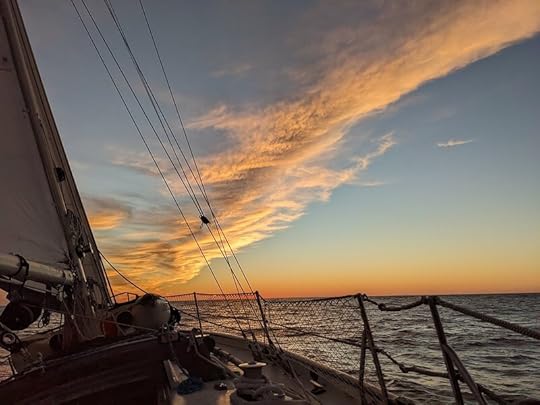
I (James) was trying to get some shut-eye on my down watch when I heard the issue actually happen in real time. The watermaker started sounding like it was slowing down, almost like it was working way too hard, then it popped the breaker.
…then it died for good! Every time I’d turn it on after that it popped the breaker.
Fucking-shit!
Eighteen hours from landfall and that was the end of it. The end of our water?! No water-no life… Wait just a goddamn minute. We gotta get this shit sussed out.
Don””’t…da-daaaaa!
Provincetown, MA, the week before Women’s Week, is not gentle (there were storms…wow!) but not necessarily violent (see below for calms).
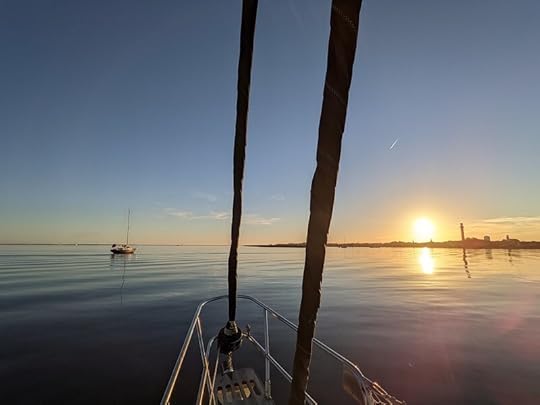
We aired our dank settee cushion covers and got ourselves ready for the next phase.
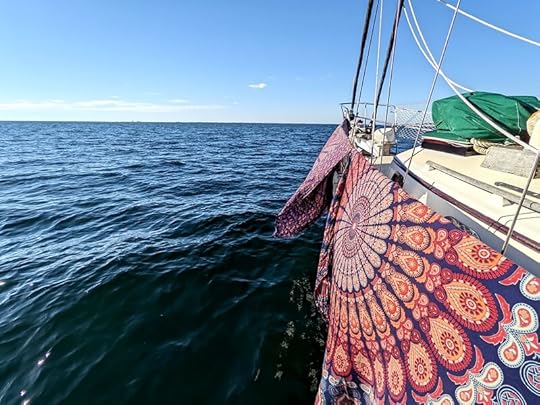
The town offered the welding we needed (see prior post) but not the electric motor specialist. We had to move on. Onset, and then New Bedford.
And yet…system failures.
Our auxiliary motor, the Yanmar 3GM30, has a boost pump fitted between the bilge-mounted diesel tank and the fuel-water separator. The bottom of the tank is marginally at-or-just-below the lift rating, called the “head”, of the motor-mounted lift pump and someone clearly thought some more pressure would be good. That boost pump failed the morning we tried to leave and we discovered both that it’s not completely necessary and that it’s not completely dead. Weirdly, the engine runs better at mid-system RPM with the boost pump fritzing out and rougher when it fritzes in. (Yes, actual info about this phenom would be quite welcome.)
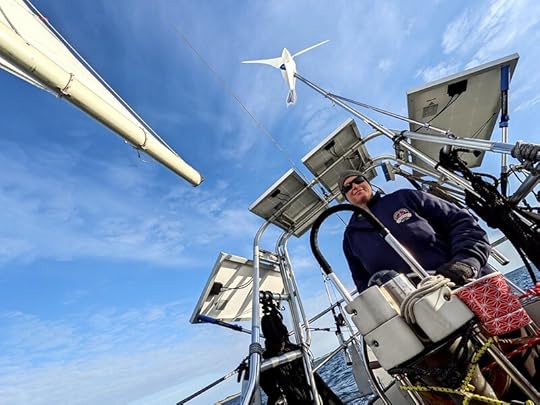 Everything is fine
Everything is fineWe left a bit later than we hoped, but we made the fair current at the Cape Cod Canal nonetheless.
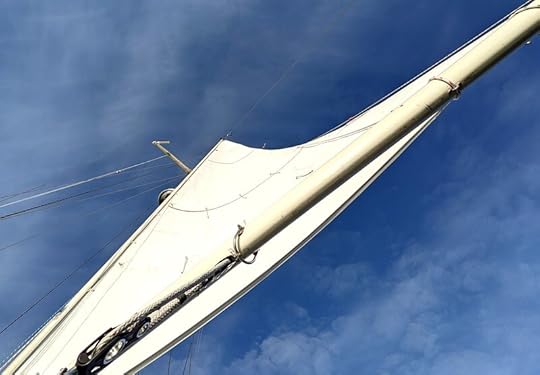
We needed to deliver the watermaker motor to the only place we’d found that wouldn’t involve renting a car: Northern Electric Motor Co, in New Bedford, MA. So we set off for one of our adventures of course.
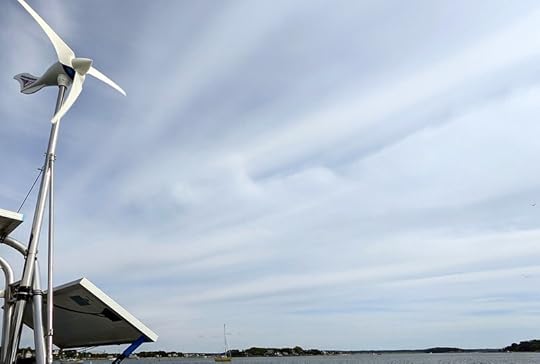
We walked about 45 minutes to the New Bedford Connector bus at the mini-mall (James carrying the heavy-ass motor), got breakfast at the Stop and Shop, and hopped aboard the bus at $1.50 each. When we got to New Bedford, I (Dena) requested the first safe stop and we got left at the side of the road, only a mile (ha! carrying that weight!) from the motor shop.
Bill met us, heard us out, and understood. He became increasingly engaged until finally, as we were leaving, James said, “I’m just so happy. This is amazing. A stand-alone motor shop!” Bill went all to glowing and we left before anyone could get too sappy.
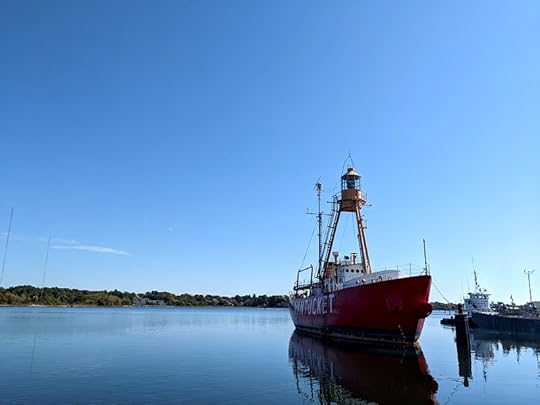 Yes, the Lightship Nantucket less than 1/10th of a mile from the motor shop… this vessel seems to follow us around.
Yes, the Lightship Nantucket less than 1/10th of a mile from the motor shop… this vessel seems to follow us around.When we got back (a long bus ride and then a long shopping for groceries while later), it seemed like leaving the next day was a sure thing. We were on our way back to Cetacea in the dink when Dena got a call from Bill at the motor shop telling us that he had repaired our motor and it was ready for pick-up.
Yesssss!
Then I (James) got sick. I mean really fucking sick in a way that nobody likes to talk about. The kind of sick that I like to bury so deep in my memories that it’s best we leave it right there…. But I’m not going to…I was rude-sick…I was stink-sick…I was, well, you get it. I woke up the next morning with visions of sailing to New Bedford, picking up our watermaker motor, and doing that repair but instead I shit and puked my fucking guts out.
And I (Dena) did the trip to New Bedford again. It’s stressful to be away from a sick partner, and I hadn’t charged my phone the night before so had to keep it off most of the time. I missed the fist bus, or the bus missed me…I’m still not sure which…and so I oobed to the grocery store where I picked up the bum-fuck-connector-bus. Back at the motor shop, Bill told me that someone had used that motor hard. The brushes weren’t toast, but the graphite brush-dust had mixed with the salty boat-damp and some leaked mid-weight oil from the drive unit to create a gummy paste. The warmth from our use of that motor softened it enough for it to flow between the copper coils and…no more DC motor. He literally just did a deep cleaning, oil’d-er-up and sealed it.
Getting back to the boat was a relief, but I knew as soon as I stepped aboard that James was Not Okay. Sick-smell and that abstracted look in his eyes combined to signal that even meeting me in the cockpit had been more movement than he should have been doing. He got sick again right then and went to bed after.
The next day was a high-winds situation. Another boat, Erik’s Allied Seawind Pelican, had anchored rather near to us. He’s a friend of Benjamin’s, which means we’re well-disposed to like him but we tend to look askance at people who anchor close in wide-open spaces. He has a keep-it-simple philosophy, which we appreciate though our practice differs from his at least in the watermaker-arena. If James hadn’t been sick, we probably would have found out more about how we shared ideas or disagreed. That can be really fun, and our boats did look great together in that anchorage.
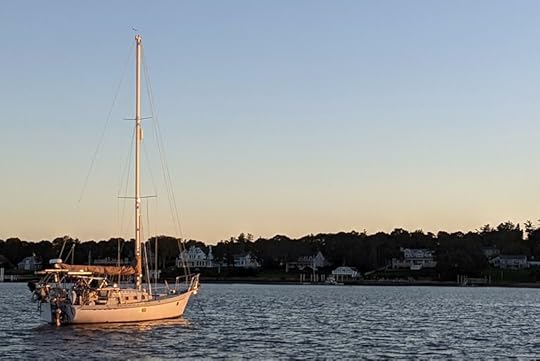
I found out that he’d put out more chain (and was still short-scoped by our reckoning), so we put out our last 50′ just to have a bit more room between us. While nature did her thing, we did ours.
We tested the motor under no load and it worked.
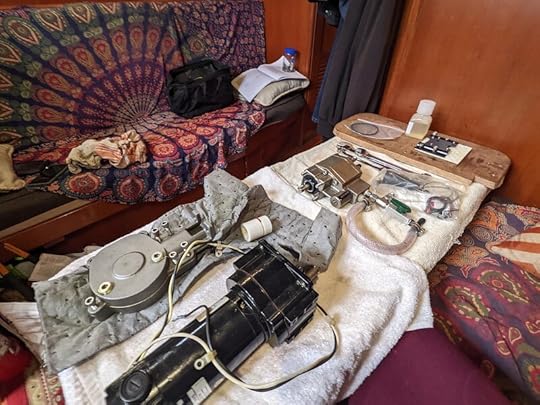
We laid out all the parts of the watermaker system. What Bill at Northern Electric said about someone using this thing hard got us thinking. The instructions for the PowerSurvivor call for a seal repair kit every 1000 hours. Who knows when it had actually been done last. The installer hadn’t put in an hour meter. (Yes, we did.)
So, before we put the drive unit back on the motor and bolted the pump back on the drive unit, we did the rebuild on the pump.
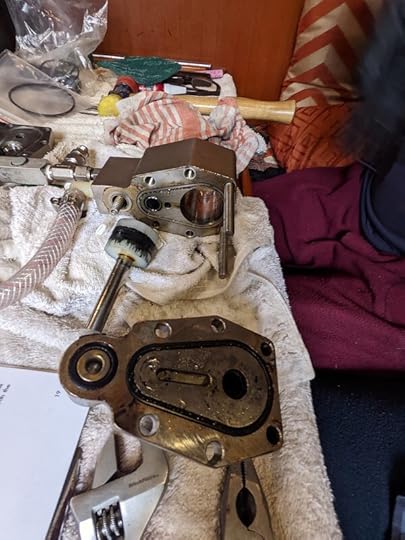
Just like what Bill said about the motor, the pump was dirty. Silicone lube is the only type you can use in an application where it can/will come in contact with the R/O membrane, but clearly that stuff gets dirty like any other lube. We took it all apart, very carefully, and then we cleaned.
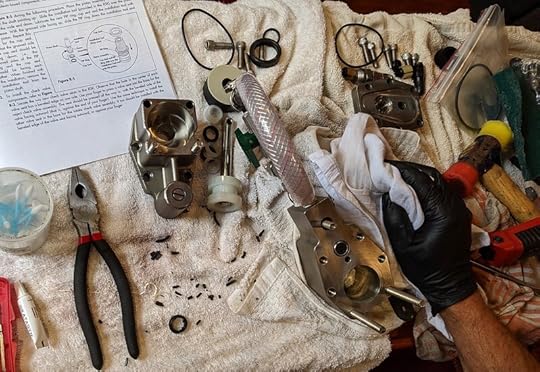
Not everything came apart easily, as you can see from those broken bits in the picture above. That’s the seal in the wiper for the piston shaft. Yes, we did have a replacement in the kit.
Project part one complete!

The drive unit was the real question mark. Katadyn says that you can’t take the oil-filled drive unit apart without replacing it altogether with the $500 replacement (a greased-bearing version of the elliptical drive and yes, I do love this language). When we took the drive unit apart to try the motor under no-load conditions, we were deeply concerned by the disintegration of the reddish plastic seal that holds the piston ring shaft in place. The merest smidge of the broken piece is visible in the otherwise empty groove shown below.
 That elliptical drive is sexy, amirite?
That elliptical drive is sexy, amirite?Since we didn’t have a replacement and didn’t want to pay $500 and stay put 2 weeks for shipping, we winged it. A redudant o-ring for the filter housing was easily cut to the right length. Just long enough to seal the oil in, just short enough to allow the pin to nestle within that groove and hold the piston ring shaft still while the piston did its piston’y thing.
Anyway, we fix our shit…we fucking fix our shit… we motherfucking fix our shit!!!
…the sound of freedom!These watermakers are a hell-of-a-lot more rugged than most people believe but we really did drive this one to the very end. But they are build using that world-famous Eli Whitney invention…Interchangeable Parts! And we’ve always believed that if it’s built by humans from interchangeable parts it’s built to be repaired by humans…that’s us. And we did…and now we have a totally working watermaker not from belief but from the work that we did.
Fuck yeah!

October 8, 2022
Yarmouth to P-Town
Ocean sailing is truly like a dream.
We got up before the sun and made ready in short order. Cetacea had remained ship-shape for our entire Canadian sojourn so making ready was just a matter of weighing anchor. I (Dena) hauled that nasty chain, three weeks sunk into the stinking blood pudding that Yarmouth Harbor calls bottom mud. It took a long time because I kept trying to dislodge the mud by pumping the chain up and down. The anchor left the bottom at 0529.
I (James) had the first watch in the dark without a working local chart on the chartplotter so navigating was a matter of following the former track-line (easy) and dodging the local fishing industry (not so easy). It was, let’s just say, interesting.
With the mainsail up as we exited the Yarmouth River and the sun just rising, the mass of ocean before us was just a little too much for my (still James here) equilibrium to take and I was overwhelmed with sickness as soon as Dena took the helm for her watch. I retched over the side for a few horrible moments and then it was all over for the rest of the trip. Mental note: take the meclazine the evening before, not the morning of.
It was an absolutely splendid sailing experience for the first 29 hours. With the wind just forward of the beam, we played all the sail options. First we had everything out, but I (Dena) pulled the first reef in the main before 10am. That eased the helm for the Monitor, then James rolled in some staysail when it got brisk. He pulled it back out before his hour was up in a 10-knot wind on the beam. In the lulls, the wind shifted forward and we stalled and, in the gusts, we heeled into the boat’s strongest attitude.
We did our standard one-hour watches during the day with four three-hour watches overnight giving us two Dog-Watches.
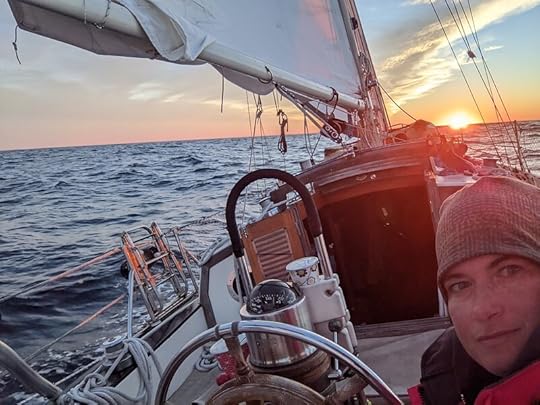
On my 1800-2100 watch, the sunset light blasted bright across the sky to windward, fogged pink to leeward. As the light faded, the moon set prematurely into the cloudbank. I sheeted in again and again as the wind eased, bringing it farther forward than before. We were sailing at the perfect angle to the unassuming waves, making for me think about the descriptions of this boat as “seakindly”. Full dark set in about an hour before James took over.
My (James’s) night watches were as long and dark as our partially cloudy moonless nights promised they’d be. That first night was flawless! Like I said before it was dark but the boat was clipping along at her new comfort speed between 5.5 and 6.5 knots all night long. So all I really had to do was watch and fiddle with shit. Like you do.
I (Dena) found Polaris on my 2400-0300 shift and destabilized myself with a new understanding, strong enough to be called a realization, of the Earth’s spin and how it makes it look like the stars move across the sky every night. Those perspective shifts thrill me to the core, and I just happened to be listening to Brian Eno when it happened. Perfect. Jupiter was just out of Orion’s reach and Andromeda was visited by a falling star. It was a great shift.
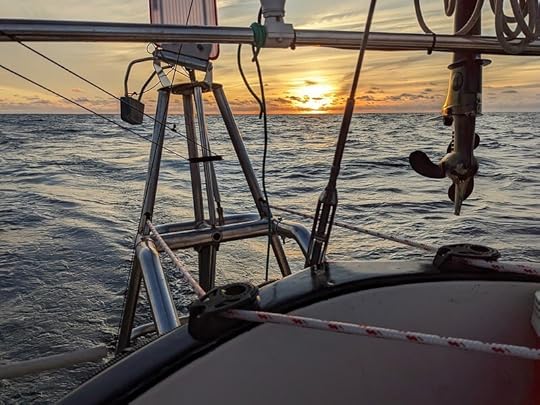
My 0600-0700 watch saw the sun come up but the wind begin to fail and fall behind, so I cranked the main to full. We trimmed the rig almost non-stop all throughout that first 29 hour stretch getting every last breath of wind we possibly could before 1100 the next morning. When the wind just up-n-died. The seas were sloppy from a-beam so leaving even the mainsail aloft (our standard practice) wasn’t even a thought.
Normally we take a half-hour watch at noon so we can switch it up at night but this time we just kind of blew that off. We left everything ready just in case we got even the slightest puff but nothing ever happened. We ended up motoring for the next 12 hours. Like it does most of the time motoring a sailboat totally sucks the proverbial bag-o-dicks.
https://flic.kr/p/2nRqgf6At least we had LoveBot 2.1, where the tiller pilot uses the Monitor to drive the boat. We were 65 NM off Cape Cod when the steering went haywire. James took the helm and I (Dena) pulled and pushed every part but couldn’t see what was binding until I gave up and released the Monitor’s water paddle, planning to raise it out of the water if it wasn’t going to do anything but get battered. Instead of floating upward, it took off astern and then dragged roughly at the end of the tether we had tied to it.
Retrieving it revealed that a weld had broken. The damn thing wasn’t steering because it was rotating freely in the piece above. Only its buoyancy kept in place and made the problem impossible for me to see with it deployed. Well. That would have to be fixed.
The other shitty thing about that day was the dying of our watermaker. It had been tripping the breaker on startup, so we lubed the piston with silicone grease (yes, I hear what I just said and yes, you have dirty mind). We were keeping an ear on the tone of the motor and, sure enough, it lagged and then just stopped working altogether. This is bad for us and, yes, needs to be fixed.
My (Dena’s) sunset watch was flat grey that just faded into dark. Some stars were visible, but not many. The moon was hazed out long before it went under the horizon, and we motored on.
I (James again) took the helm with a kind of vigor that I really wasn’t anticipating. I fucking totally got into it. There was a cargo ship 3km off our port bow on a half-mile crossing vector that kept me focused for an hour of so and the stupid ocean-raper-purse-seiner that barked at me for wanting to maintain my course when he was “Fish’n here!” When the poacher and his bright (fucking) lights had finally fallen astern I got the most beautiful dolphin show I’ve ever seen. The porpoise’s bodies were lit up with the millions of green bio-luminescent creatures of the black ocean around Cetacea. I could see them perfectly in the light. It was a pod of about 10 adults and a couple of little ones. One of them whistled at me to starboard and then swam under the boat and whistled again to port then laughed at me in a kind of witchy cackle that had me and Beluga Greyfinger in stitches. Kitty and I were absolutely enthralled by the light show for about an hour. I knew that Dena hadn’t really gotten any sleep up until then so the only witnesses to our dolphin show were kitty and I.
When James gave me that shift kiss just north of Race Point Light, I knew it would be another couple of hours before we were safely anchored and done with the trip. The home stretch felt good, though, because I know this place and had no fear of running aground or missing the best anchorage area. I did have to dodge, startled, some buoys with tall flags on them, but that’s not so bad.
We weren’t the only people looking to sit out the 35-knot winds the Ian-remnants would bring, so I had to circle to find the best, safest, least worrisome spot that also didn’t put us distressingly far from the town dinghy dock. It was so dark that James helped with the spotlight on the bow, and I carefully eyed the combination of anchor lights and radar returns in order to settle the question. Finally, in a good spot, I called out, “Ready, drop it.” James called back, “Anchor’s on the bottom.” We put out all 200 feet, tidied up, and went below to a happy kitty.
We traveled 224.6 NM in 1 day and 20 hours, which is a spanking pace for us. But this is also the end to another incredible down-east chapter for the crew of the S/VS.N. Cetacea.
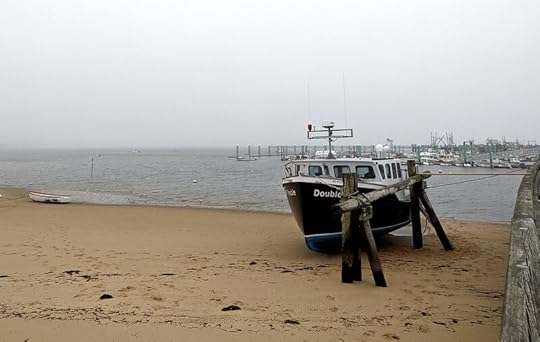
Now, let’s get south!

October 6, 2022
System failures…
…are no doubt part of the game when it comes to offshore sailing.

The offshore passage to Cape Cod from Nova Scotia had a system failure that took us both by surprise. The Monitor self-steering rudder broke. Cracked in two ten hours before we were hook down in P-Town. We were glass becalmed entering the Cape Cod tidal influence and making about six good knots over the ground. LoveBot 2.1 was driving Cetacea along just perfectly when I (James) left the helm after my last daytime watch.
Shift kiss!
I (Dena) monitored our course and kept a sharp eye out for sign of cetaceans. We weren’t that far from Stellwagen Bank. We started to back around too far south and I looked back at LoveBot. The swinging rudder was hard over to starboard, which steers us to port. I tried adjusting the tiller pilot portion, then the wheel adapter portion, but I couldn’t get it to straighten up.
I pulled the cord that releases the rudder so it can be raised when not in use and a busy foamy froth erupted where it should have appeared. I called for James and he came to take the helm while I figured out WTF.
We had the rudder set up to be retrieved by pulling on a length of seine twine. When I hauled on that, the pressure on that thin line cutting into my fingers. To my utter surprise, the entire rudder banged off LoveBot’s frame on its way up to me…completely unattached to the Monitor.
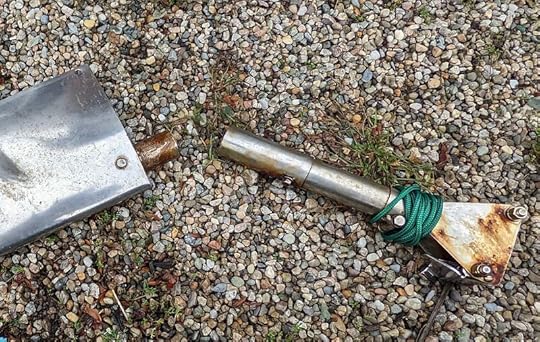
Someone (Not Fucking Us) beat the hell out of this Monitor windvane. LoveBot has been through at least one bad accident. When we put her on Cetacea she was bent to hell so we knew we were going to have some surprises ahead. The frame has a lower curve in it that means we tie the control lines on the bottom in half-hitches to make right angles and I’m [James is] telling you it works…until it doesn’t! Fuck! The rudder had clearly been previously manipulated (quoting myself “I’m being kind”) by someone with access to sheet and tube metal and a fair knowledge of welding (says Dena), if not much in the way of aesthetic flair. (I [James]think that was Dena being kind…kind of.)
In the picture above, the tube on the rudder slips over the tube on the hinge assembly. (That’s what’s all the way to the right in the photo.) Those two pieces were held together by a weld that went all the way around. The weld had failed, but the buoyancy of the foam inside the rudder had kept the rudder in place until Dena let the whole thing fold up behind us and it tried to take off…like float away in her hands held only by sharp-ass’d seine twine! Ouch! (visions of Port Orchard cir.2001)(anyone remember that? crickets? It was a long time ago.)
As you should have read in the previous post (there will be a test), we hand-steered to P-town and got safely anchored. The remnants of a hurricane once known as Ian heaved over us for the first couple of days and we couldn’t get off the boat, let alone get any work done. It was infuriating until we realized we had awesome internet again!
Time to download some serials, as Murderbot would say!
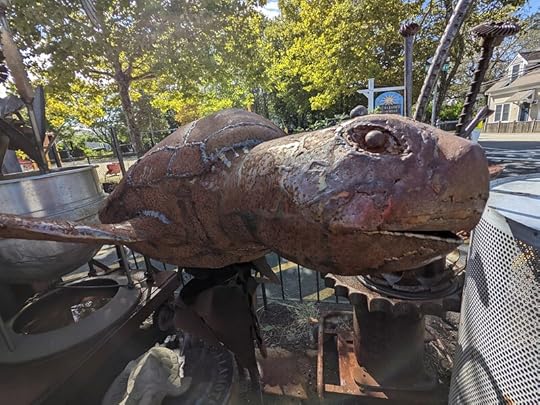
As soon as it was safe (ha! in 20 knots of steady with 30 knot gusts), we launched the dinghy, added the motor (in a four-foot sharktoothed chop), and went into town carrying the pieces of the rudder system and a desperate need for some free veggie sushi. The first welding dude with a shop we tried belonged to a guy named Madeiros, which made my (Dena’s) Azevedo-descended heart happy, but he was shoulder-deep in getting a septic-tank-sucker truck back in business and had another commercial truck waiting for when he was done with that.
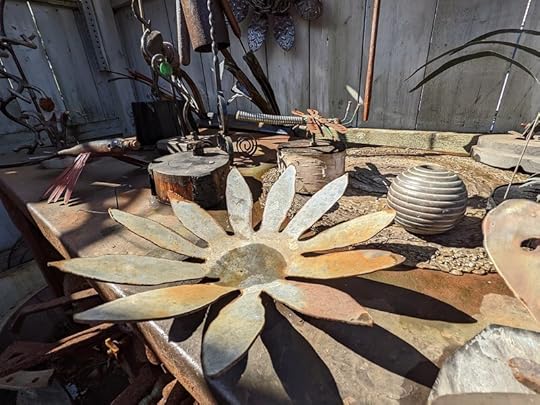
In what seemed like the same amount of time it would have taken for him to weld it, he worked out who could do the work (Adam at Provincetown Welding Works) and where he was (Stop and Shop) and when he could be at the shop (right about the time we’d arrive by foot). I’ve been leading up to this with the artwork that fronts the shop…studio? It was definitely not the place a septic system maintenance truck would come for the most solid utilitarian work. He might end up with a turtle head on the back of that shit.
We talked over the project with Adam (the “kind of” owner), left long enough to get lunch, and came back to him grinding his freshly made welds. Then, he intimated that the repair wouldn’t hold forever and offered to put a bolt through as well (belt and braces, as he said).
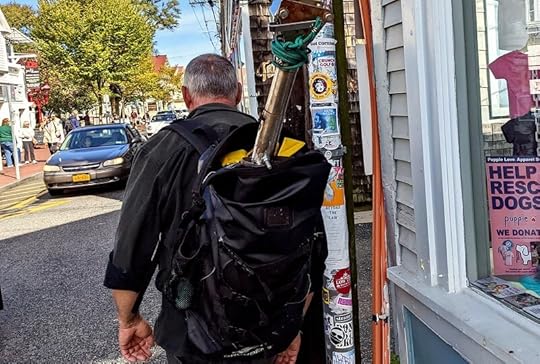
It was a thin-walled stainless-steel repair on the fly! That’s what you get on the the fly. We were thrilled! Adam did the best he could in a git-r-done ASAP kinda way and I (James) packed that rudder in my pack and hauled her back to S/VS.N. Cetacea, home. As you can see above, looking left would shatter a window and looking right would clock a tourist.
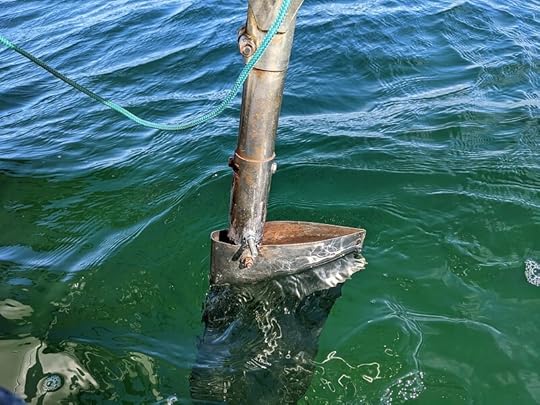
It worked! Or at least I (James) truly believed it worked. I mean, it looks (if not perfect then certainly awesome) like it could work.
“And I’m outta here!”

September 28, 2022
Lighthouses and Fiona
Nova Scotia (or some subset of Nova Scotians the makeup of which I cannot really imagine) have designated a certain route around the southern coast as the “Lighthouse Route”. There are signs from Yarmouth south and around to Halifax.
Being us, we were totally stoked about seeing parts of Nova Scotia that the weather and lack of charts had made difficult, especially the plethora of lighthouses. Also being us, we were surprised to find that the lighthouses had no “scenic overview” not even a pull-off or a car-park from which to see them. Being us, we made due where we could.
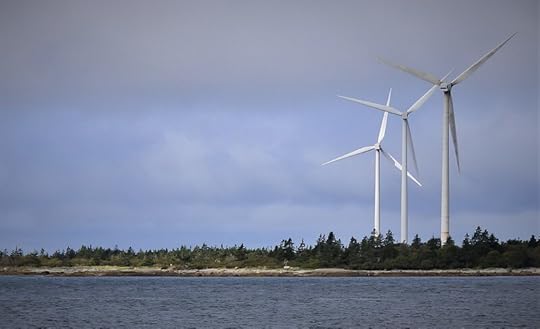
The first one we could figure out how to get close to, meaning driving down residential roads and parking at a traffic barrier, was the Pubnico Harbour Lighthouse. We ended up thrilled because, across the way, a wind farm flashed in the on-and-off sunlight.
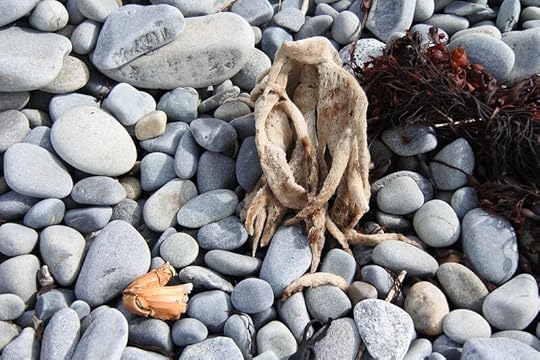
We clambered over tide-tumbled rock to get closer to the prize, and found prizes along the way. Also found, assorted evidences of human carelessness, especially lobster bands (what they put around the claws). On the other hand, there was that lighthouse…
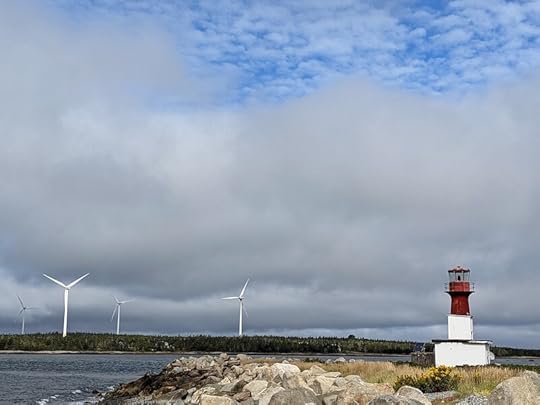
The natural, the civilized, and the human…all in one incursion of the Atlantic Ocean.
Heading south from Yarmouth, we were driving toward Cape Sable. The bounds of the Atlantic Ocean and the Bay of Fundy and the Gulf of Maine are all so much less precise than those land-lines that separate countries, so it’s a little hard to say exactly what bodies of water we were looking at. We were in broken, rocky groups of islands and islets and ledges. Those hazards have always been safer navigated if marked, visually, by lights, and the people who settled here, from the French Acadians to the British battle-hardened to the American Loyalists to the mixed heritage folk who live there now, well, they weren’t navigating like the Mi’kmaq in shallow draft deerskin-canoes . They needed lights.
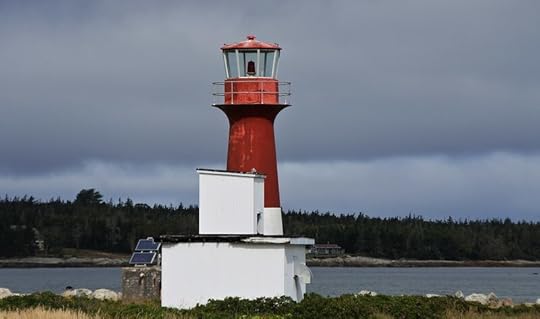
The privateers needed them and the fishers needed them and basically every damn thing they cared about was about getting around and through the dangerous rocky shallows to safe harbor.
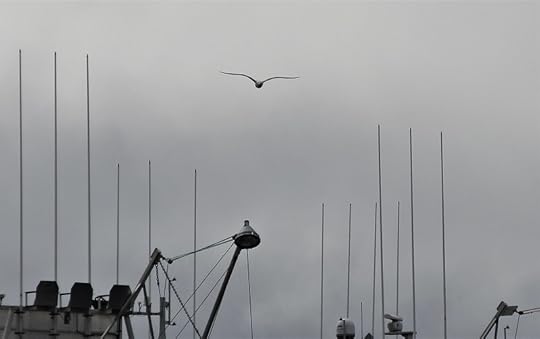
Today, from land, seeing the lighthouses pretty much depends on a harbo(u)r being nearby.

Most of the lighthouses along that “Lighthouse Route”? No visibility from land. A few, though? Quite nice.
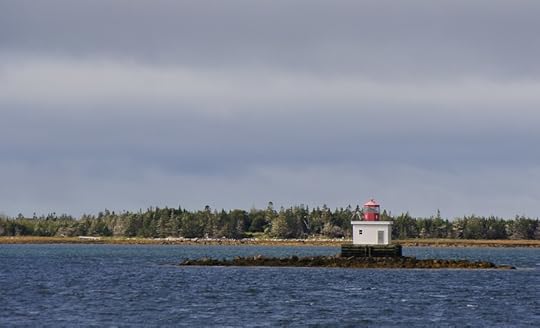
One had been moved inland for posterity.
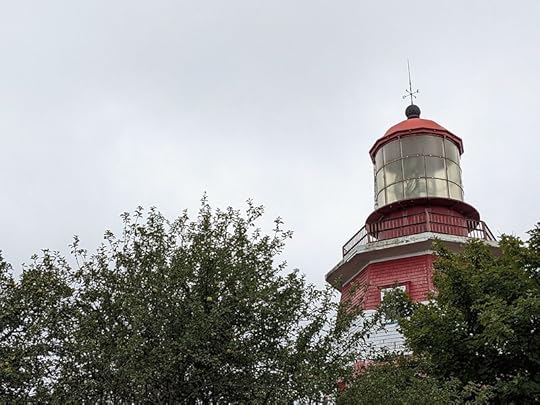
We drove quite a ways without seeing most of the lighthouses that were out there, but hit Halifax in midafternoon which is the perfect time to get sushi. The server there was not tuned in to the weather that was coming down. We’d been about nothing but Hurricane Fiona, distracting ourselves in fact from Fiona on that very trip. I hope that we influenced her to check the forecasts because Halifax got pretty well battered by that one.
We crossed the peninsula and went from tides less than 10 feet to a 34-foot tide that gave us a visual aid for why the currents were so profound in the Bay of Fundy.
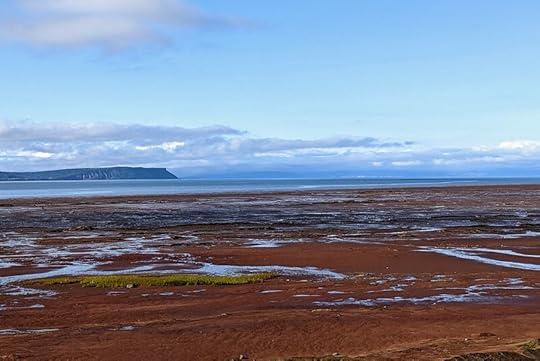 A 35ft tide at Evangeline Beach on the Western side of Nova Scotia.
A 35ft tide at Evangeline Beach on the Western side of Nova Scotia. Point Prim lighthouse in a low-light sunset, and we were happy to head back to the boat and Beluga Greyfinger.
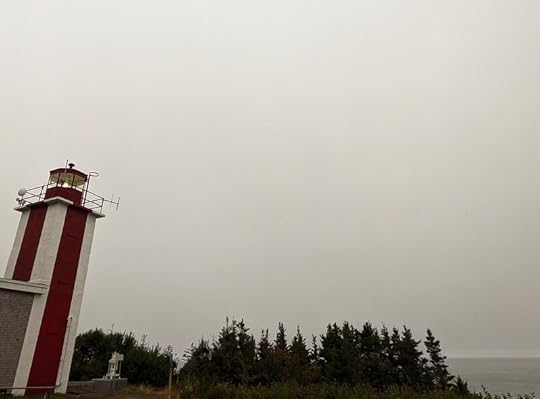
We returned that rental car about 8 hours before Fiona made our lives miserable for the next 24. As usual, we have very few photos of this reality. Several boats arrived. One had to be chased away because they were TOO CLOSE. Another anchored far enough but we’d have to keep an eye out. A third circled the harbor a few times and then set their hook but failed to figure in the 14′ tide. They had no idea they would be on the mud, fully out of the water, by low tide. It took a kind local going out to tell them. They tried to reset quite a bit too close to us, we (the local in an inflatable dinghy that had irritated us by tying up sideways and me, Dena)convinced them that paying $30 per day for a mooring was a better idea than dragging down on us.
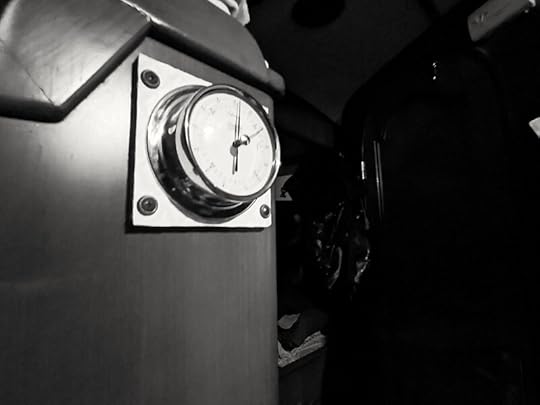
Fiona was a big deal, but not the end of the world. Big wind made it difficult to do regular things (cook, pee, sleep, etc), but we didn’t drag and the other boats didn’t drag into us. Fiona made a mess of other parts of Nova Scotia, but in Yarmouth only the unprepared few experienced things like deck furniture breaking their windows. People around here are used to the weather getting mean now and again.
We had the usual feedback loop of calming the kitty and therefore calming ourselves all throughout the storm, and we made it through. We suffered no damage that we could find in our post-storm inspection (which is pretty damn thorough) so all we had to do was wait for our next weather window of sou’-westerly opportunity.
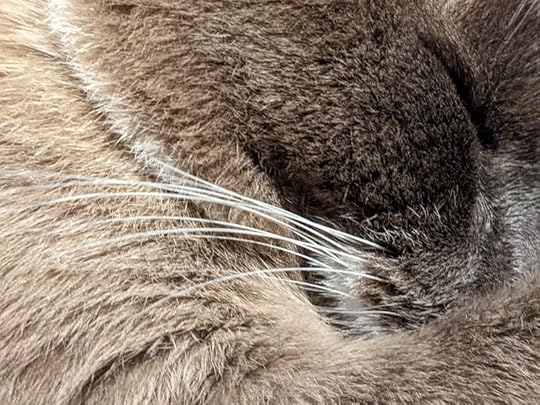
There were plenty of reasons to be creeped out by the fishing industry in Yarmouth and some very puzzling incidents (like the Vietnamese place called Just Pho You where we entered, took all our layers off, and waiting for quite some time before realizing that the workers had just left the door open and gone…somewhere), but there were some very wonderful things as well. After the storm, we showered and did more laundry using the key that the harbormaster gave us the day we arrived. We’d asked if we could pay some kind of fee to use the showers even though we weren’t on their dock or moorings, and he said there was no need to pay. In those three weeks, we had more showers than we’d gotten since leaving Lynn!
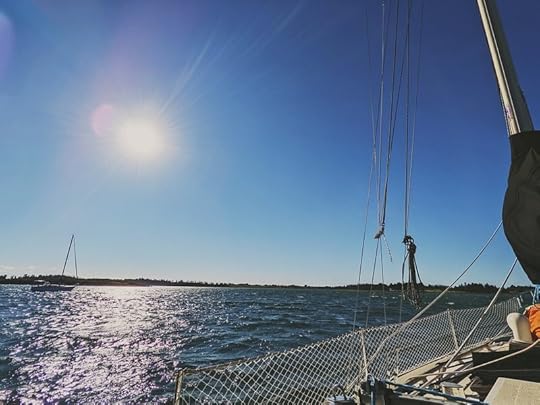
Other odd culinary experiences…the Mexican restaurant, Mr Gonzalez’s, had a Taco Bell/KFC right next to it. Of course, we were not going to go to Taco Bell…but Mr Gonzalez was on vacation…the whole time we were there.
One of the first things we discovered is that there’s this thing called Donair sauce. It’s a Greek immigrant’s answer to the fact that their gyros weren’t attractive to the locals, and it is quite simply condensed milk, vinegar, and garlic powder. We were given a prepackaged container of it along with a pizza we’d ordered and I (Dena) wanted to spit it back out right after it touched my tongue. Luckily, I tried it right off the bat and so had plenty of other food to erase the taste. Knowing about this thing tuned our antennae and we realized that there was a theme here. Everything was a bit sweeter than I would ordinarily expect, from salad dressings to an unforgettably bad pizza sauce at a different chain. Luckily, they kept the white wine broth for the mussels simple at The Rudder, and holy shit was that a good meal.
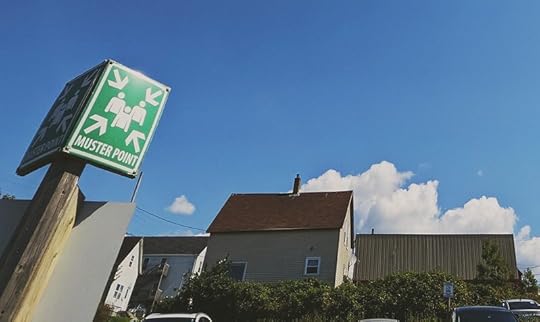
A weather window opened, and we eagerly grasped the opportunity to get the fuck out of Yarmouth, our home in Nova Scotia for a total of three whole weeks. One last shower and a trip to the drug store…Random piece of information…meclazine (generic Dramamine) is a controlled substance in Canada, requiring your health card if you have one or a whole form that needs filling out if you don’t. Surprised me. Anyway, and shipping the dinghy, and we went to bed early so we could get out of Yarmouth Harbor before the current turned against us early the next morning.

September 20, 2022
New Scotland or what?
The shadows were getting long like it was autumn but it felt all too soon.
 Oh, it’s Canada again!
Oh, it’s Canada again!The anchorage in Yarmouth, Nova Scotia, is beautiful looking west to Doctors Island. It’s one of those places that looks exactly like it would’ve about hundred years ago. The sun sets over the island and the green rolling hills beyond are a reminder of so many things we’ve lost looking East.
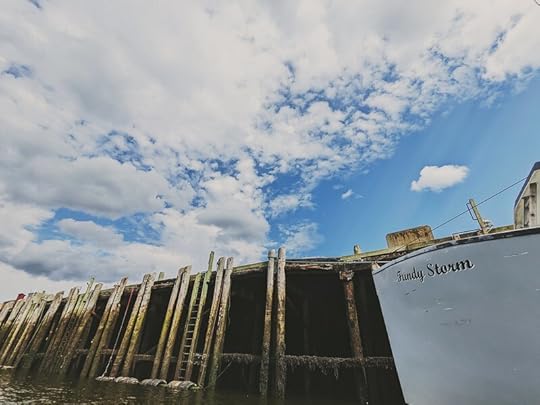 The F/V Fundy Storm at port.
The F/V Fundy Storm at port.East of our anchorage was a seafood processing plant with three resident purse-seining vessels that go out every night. Every morning they would return to the docks after a night of scooping the life out of the ocean and they would unload their bellies into the plant for processing. One giant vacuum would suck the fish out of the holds and another would suck the bloody by-catch into a giant Dr. Seuss machine that would in turn bletch bloody gruel into a giant vat that opened at the bottom with massive jaws. An eighteen-wheeler would back in under the vat and the jaws would puke the guts of the sea into its spill-proof aluminum catchment. Every day, every single day, this happened right in front of us.
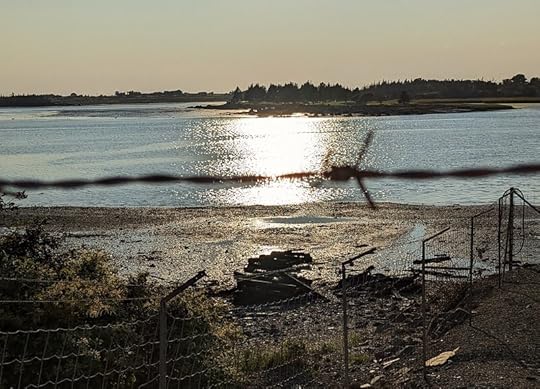 From the fish processing plant
From the fish processing plantWe were impressed that they shipped away the effluvium, enjoying the thought that nothing went to waste. It would become some kind of nutrient in some kind of product, and that seemed better than the alternative.
And then they cleaned the vat.
The waters around us turned dark with blood, sudsy highlights only making the horrible truth clearer. The bloody feast attracted the swarms of sea birds that had been circling the boats and the large harbor seals that never seemed to hang out together. I can’t imagine what the (presumably biodegradable?) soap did to them, but they were more than happy to chance it.
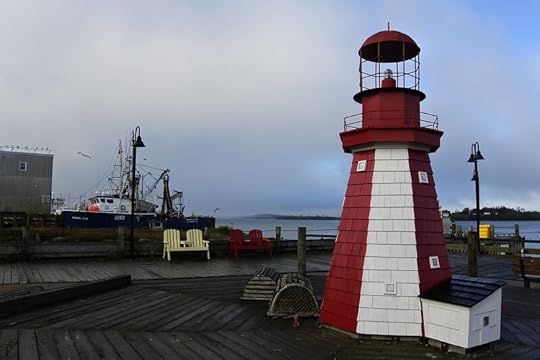
The waterfront has charm for folks like us – working class with some special touches.
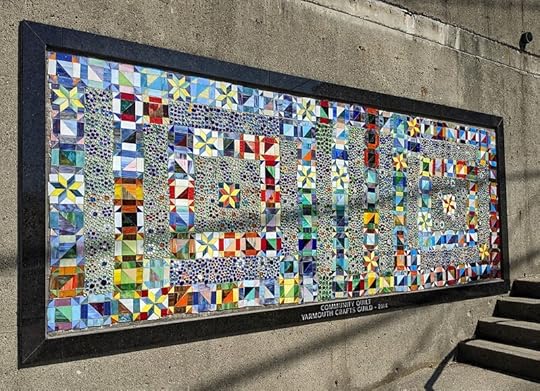
A waterfront park with a lost-at-sea memorial isn’t uncommon, but it was rather sobering that this one had a lot of room to grow.
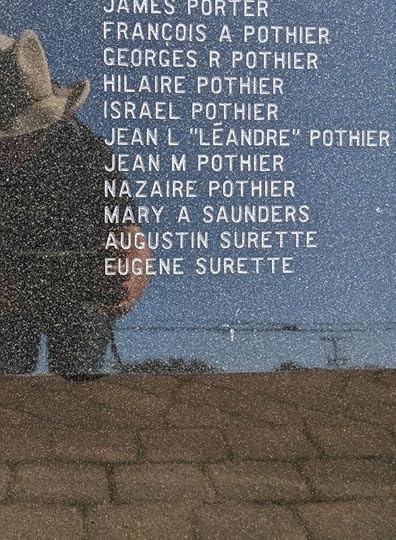
We got a meal we didn’t have to cook or clean up, and that made us happy.
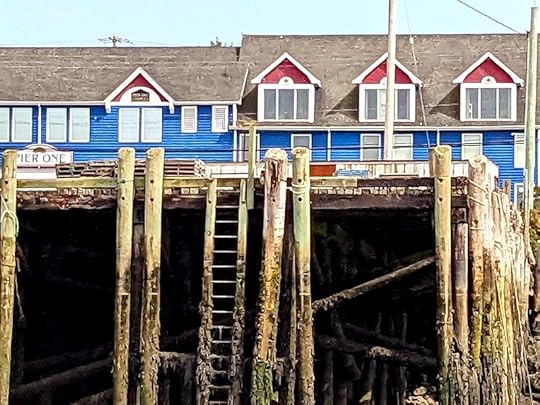
Those 17 foot tides were impressive but the current wasn’t the kind of factor we’d dealt with many other places (the Cowyard in Plymouth, the Hudson off 79th Street, etc, etc).
The town’s character combines the brutality of the seafood industry with an energetic enthusiasm for arts and, well, queers. We couldn’t go far without seeing a pride flag, often with an explicit statement of support and welcome.

We scoped out all the nearby shops and quickly realized that we would have to walk out to the highway drag for provisions. It was a three-mile round trip, which isn’t bad even weighed down, but it got old pretty quickly.
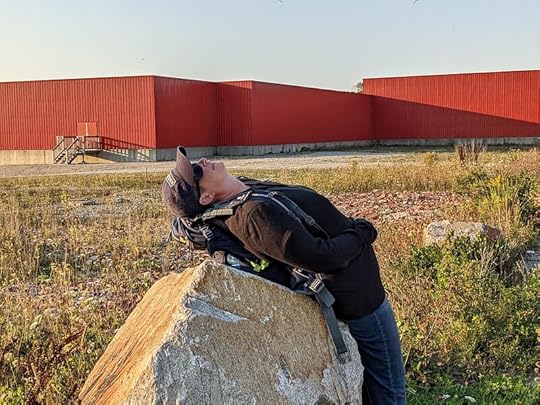
We did the industrial route. We did the highway route. Finally, we found a hike-and-bike path that cut across and put us on a much better road to walk down.

Why would we do the walk so many times? Well, see, the weather was shit and we still hadn’t managed to get charts for Canada.
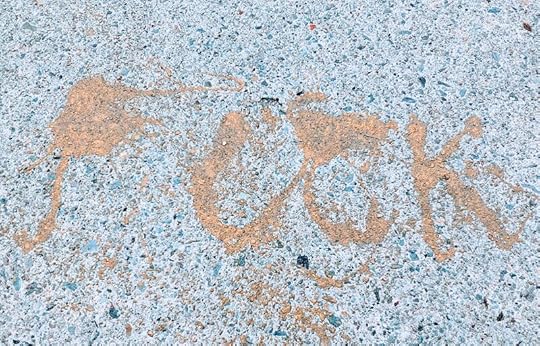
We bought the c-map chart package for Canada because we could download the charts rather than figuring out how and when to get the SD shipped to us. Our internet was absolute shit, so we paid extra to speed it up but the charts were 28 gigs (!) so that couldn’t get it done. Then we sat in the covid-era outdoor seating at a nearby cafe and finally got the chart package downloaded.
It didn’t work.
So we were in Canada without a very important tool for the rocky ledges of the coast down to and around Cape Sable. Our options were to keep using our less-than-awesome system for navigating the Canadian coast or do our big hop down to Provincetown. Or even bounce along Maine. The weather kept spinning circles, which is pretty good for gunkholing but less good for multi-day passages. Hurricane Earl tapped out south of us but still created a surge that would have made travel a barf-bother.
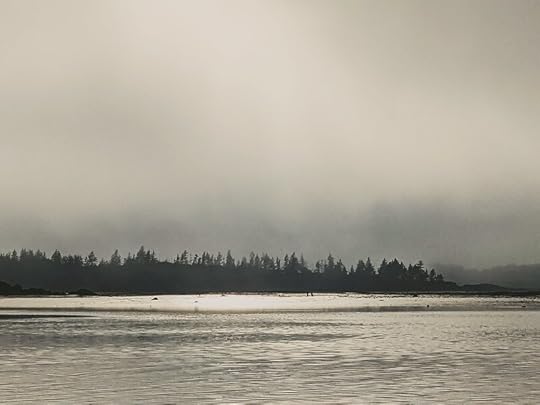
We did a lot of walking, made some truly amazing meals aboard, and worked on our books. A shat-a-moron arrived and anchored a safe distance from us.
And then we started watching Fiona. Feeling edgy and irritable. We had arrived September 7th, and it was the 19th and we were getting cabin fever. The comings and goings of the Death, Inc vessels had stopped being impressive weeks before (they do have excellent captains) and the slimy blood coating our hull, our boarding ladder, the dinghy and its painter soured us on them even further. It’s a sign of how much we liked the town that it wasn’t driving us batty as well.
We decided to do a trip by car before Fiona was forecasted to arrive. Of course, the next day we could see we’d be lashed with heavy rain so we wouldn’t enjoy driving and wouldn’t see anything.
We booked a car for the 21st and planned a lighthouse tour of western Nova Scotia.

September 6, 2022
On to Yarmouth, N.S.
The sail from Freeport to Yarmouth, Nova Scotia, was a git’r done kind of day. We motorsailed with main only for the entire day. The currents in St. Mary’s Bay weren’t as intense as what we had gotten in the Bay of Fundy and the wind was so light that we just wanted to get there.
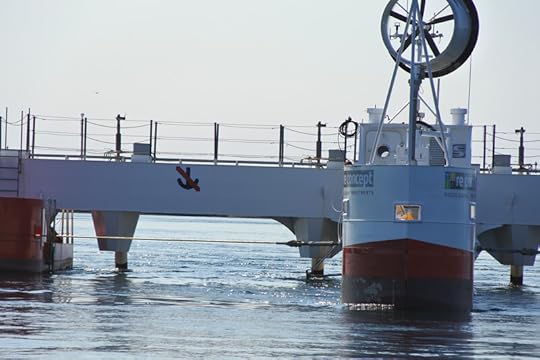 The Grand Passage Tidal Energy System
The Grand Passage Tidal Energy SystemBefore we got out into the open waters of St. Mary’s Bay we had to navigate our way through the channel between Brier Island and Peter Island which is the pinch that has the max-current in the passage. It was intense to say the least. We wanted to get as close to the Grand Passage Tidal Energy System’s barge as we could without getting in the way of that insane ferry course and that maneuver turned out to be nothing short of a feat of brilliant navigation that Dena handled flawlessly. I (James) took some pictures and enjoyed watching her work.
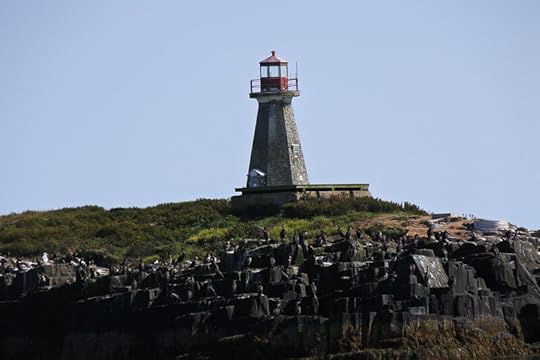 Peter Island Light
Peter Island LightAlso seen on the way out, a simple red building that has an interesting history for those of us who read and loved Joshua Slocum’s Sailing Alone Around the World.
We were never out of sight of mainland Nova Scotia once we enter St. Mary’s Bay and the glassy waters and warm day made for an almost hypnotic passage across the bay.
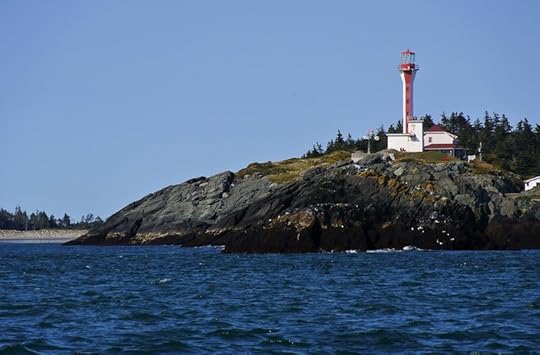
Rounding Cape Fourchu, we lost our current-assist and slowed a bit. The light pictured above is visible for quite some time. James and I have a similar appreciation for lighthouses as products of true civilization, so it was a pleasure to come around it.
The channel up into the harbor made a turn directly into the wind, so we struck the main earlier than usual. Using the handheld tech for chartplotting and the chartplotter for depth was as weird as when we’d done it on Grand Manan and in Grand Passage, but we had the pleasure of another lighthouse along the way.
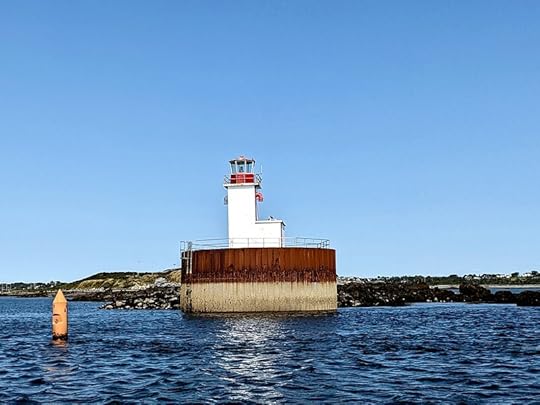
Bunker Island Lighthouse was an unexpected pleasure, and then we were in the harbor. The big fast ferry was in port and we knew we should pass the moorings in order to find the good anchorage. Unusually, instead of a mooring field, we found only three moorings lined up very near the abrupt ledge for Doctors Island. At high tide, the harbor looks commodious but it’s a trick. Low tide reveals that mud and rocks account for most of the area.
With our modern tools, we were able to see where we were pretty well. I (Dena) did a loop to confirm that the charted depths were accurate and then we set the anchor in the middle of that loop, safely away from the hard stuff. We didn’t figure we’d be in Yarmouth too long, and taking the dead center of the anchorage seemed safer than trying to leave room for an unlikely boat or two that might join us out there.
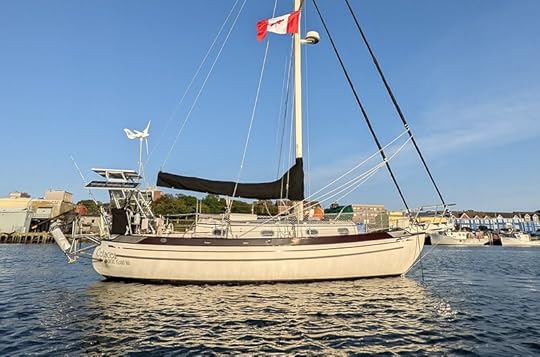

Walking Grand Manan
Oh Canada, oh man, we love Canada. The (almost cool) app-and-phone-call clear-in from the Canadian Border Patrol was an unfamiliar and somewhat unsettling experience (who expects that kind of thing to go smoothly?) so we had to put our feet on some Canadian soil.
We still had to get charts for Canada and there was a hardware store about seven miles up the road that advertised having the electronic charts we needed. Also we were getting very low on the provisions we couldn’t get in Downeast Maine, which was quite a bit, and there was a big grocery store just a few miles up the road from the hardware store. So we went for a walk, a long walk, a very long walk…on Labour Day. Kind of a big deal in Canada as it turns out.
I (James) didn’t shoot a single picture of that walk. It’s not that it wasn’t breathtaking, it totally was that, but we were just thrilled to be on a hike with each other in that beautiful place, moving at the pace of us, and seeing it all for the first time was all I really needed for my memories. We chattered quite a bit, usually enthusiastically agreeing with each other, often pointing out neat natural features or odd constructions. We also talked about our MIPs (manuscripts in progress) because I (Dena) was struggling with keeping Monty’s story in focus. The cloud-filtered light was easy on our eyes and the greens had a special richness against the grey sky. We were decked out in the exact right clothing for what felt like a refreshingly cool day.
The fucking hardware store was closed. It was a national holiday celebrating working folks and I guess that what they did there, they worked. And on Labour Day they didn’t. So, no charts of Canada. We had used a combination of tools to get anchored in Seal Cove – the Simrad chartplotter for sonar and radar and our handheld tech running the Navionics app for the chart and our location in the world. It wasn’t the end of the world, but it was disconcerting to cadge together that particular dataset from multiple instruments.
We pushed on in hopes that grocers didn’t labour for a living which of course they do but maybe, just maybe, they celebrated their contributions to society on another day. Grocer’s Day perhaps. Canada might be cool like that.
Sure they were open but they had no butchers or pizza makers or prepared foods people working at all. It was a little weird. There were stockers labouring like crazy and plenty of check-out staff but that was it.
We loaded up with about thirty pounds of stuff for our backs and headed for the return hike back. As soon as we got out of the store it started raining.
No fucking way.
A few miles (we’re not doing the kilometer thing yet) before the grocery store we stopped in at the Grand Manan Visitor Information Centre (yeah, they have some vowel issues in Canada) right next to the totally abandoned skate-park. Just as we walked up to the building, a guy pulls up in a car and introduces himself to us as the Deputy Mayor of Grand Manon. We were adequately honored. He gave us the number to a local taxi service.
We called for a taxi from the grocery store and the guy Dena called was in a little unmarked blue car right in front of us in front of the store. He was on another run so he called someone else and she was there only moments after to take us back to the little village of Seal Cove.
We made a couple side-trips because she wasn’t really a cab driver, just a lady with a minivan who was willing to drive people around. That meant it was one of the very, very vanishingly few times we couldn’t pay for something in Canada with plastic…and the grocery store’s ATM had been out of order. The next convenience store and alcohol-getting place had an ATM that had no money in it, so we rather desperately called the one and only other place on the whole island that might keep us from being stranded by a stranger who had already done part of what we needed to pay her for. When the person on the other end of the phone confirmed that they’d filled their ATM just that morning, I (Dena) nervously asked the driver if we could go to yet another convenience store. The story ends well, with us marveling at the new (to us) Canadian plastic bills and her driving away well-tipped.
When we left Grand Manan, we were once again navigating with our tech. Once again, we got underway, got through the rocky stuff safely, and got our asses kicked by the churn. The wind and tide weren’t against each other, but the shallows were a marvel of physics, with sharp little waves going every which way. As the depth sounder registered a tripling of the depth in less than a minute, the wave action became just uncomfortable instead of actively worrisome.
We’d been joking (not joking) that one of our on-watch duties was watching for whales, and we knew that there were lots of sightings in the area we were transiting. Sure enough, a couple blows happened rather far away. On my (James’s) next watch I saw a big blow within two-hundred feet of the boat to starboard a-midships and I literally screamed (maybe squeaked a little) “Thar-She-Blows” and Dena was above decks in seconds. We were totally there in the Bay of Fundy silently (close enough) sailing by another intelligent species on Earth. This was, er, not lost on us.
Welcome to Nova Scotia.
We’re not whale chasers. We’re fellow travelers, hopeful of gaining a glimpse of the creatures we share the waters with but rarely see. The blows were exciting, but then, before I (Dena) gave up on more and went below, a whale surfaced much closer than those that had been breathing and we were treated to the sight of the perfect fluke slap. That whale said something to us, even if we couldn’t understand what it meant. The shape and coloration of the fluke’s underside was so crisp and so clear that it was easy to identify as a humpback. Thrilled and melted at the same time is a good look for us both.
The radar and AIS told a story about three boats that were perhaps less respectful. They crowded around an area we were sailing toward but not close to and then left. By the AIS data and the look of the whole thing, they were whale-watching boats that had cornered some being of interest. If that wonderful creature hadn’t been feeding, I can’t imagine it would have stayed as long as it did while boats raced their engines and gawked at it.
Grand Passage is only grand in comparison to the one a bit north. It’s between two islands (Long and Brier) that extend south of Digby Neck in what was clearly once unbroken land. The same water that broke open channels between Digby Neck and Long Island and Brier Island ushered us toward the narrow opening with the force of the Bay of Fundy. We surfed our way in and negotiated with a ferry for safe passage. That ferry’s route was eye-opening and we abandoned our planned anchorage off Westport for a less punk-rock one off Freeport.





